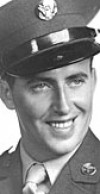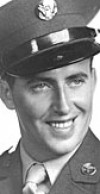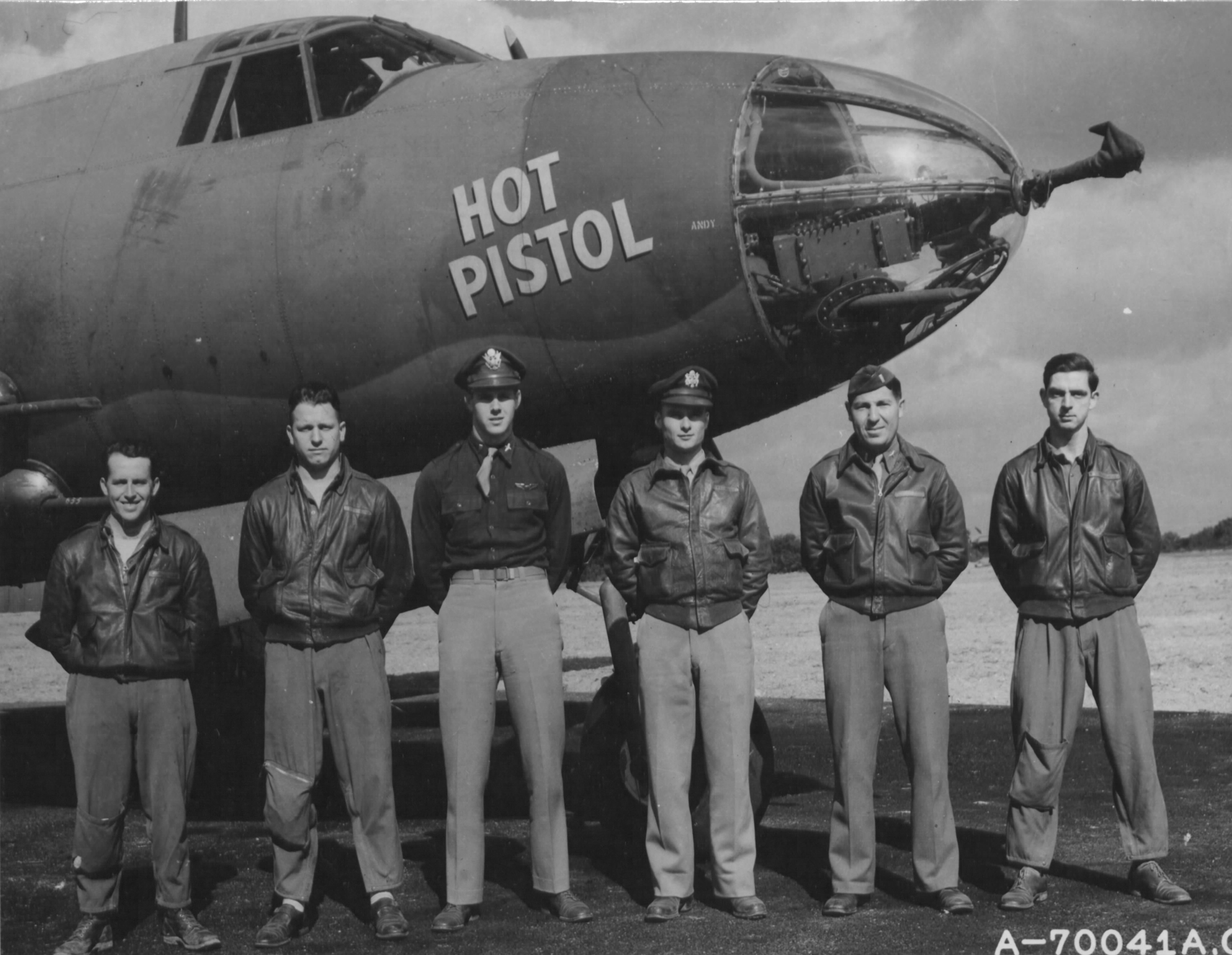Sept. 3, 1917 — Feb. 10, 2012
Lynch Hugh Everhart was born Sept. 3, 1917, to Grover and Catheryne Everhart in Dodge, N.D. He was the second of four children.
Mr. Everhart was a distinguished veteran of World War II as a sergeant with the Army Air Force serving as an armorer gunner. He fought in battles and campaigns that included Normandy, Northern France, and the air offensive in Europe. Flying in more than 70 missions, his 54th mission occurred on the most acclaimed, D-day, where he served with the 386th bomb group. He was highly decorated for his service, receiving the Good Conduct Air Medal and two Silver and one Bronze Oak Leaf clusters.
By the order of the president, Mr. Everhart was awarded the Distinguished Flying Cross, for extraordinary achievement while participating in aerial flight while serving as an armament-gunner (tail gunner) on a B-26 airplane on 25 combat bombardment missions over enemy occupied Continental Europe. His coolness and courage aided materially in the successful culmination of these vitally important missions and he was commended for his skill in handling his guns in warding off many enemy attacks directed against the safety of American personnel and aircraft.
Upon his discharge from the military in 1945, Mr. Everhart found work in Alaska, Idaho, Oregon and Washington, serving in administrative and accounting positions. Employers included Kaiser Aluminum, Johnson-Morrison-Knudesen, Boeing, The Dalles Powerhouse Constructors, Midwestern Piping & Supply, and Weyerhaeuser Pulp Division. He eventually settled in Spokane where he worked as a postal clerk with the United State Postal Service for 25 years, retiring in 1979. In 2003, he returned to Longview to be closer to family.
Mr. Everhart is survived by a nephew, Floyd Steen Jr. (Normal); a niece-in-law, Carol Steen; three grandnieces, Pama Joyner (Frank), Lynda Renz (Bill) and Monica Steen; a grandnephew, Blake Steen; a great-grandniece; and three great-grandnephews.
Mr. Everhart was preceded in death by his first wife, Teresa (Maloney) in 1986; his second wife, Dorothy (Parker) in 2000; three sisters, Alice Steen, Nina Hedman and Lucille Nichols; a nephew, Robert Steen; and a niece-in-law, Barbara Steen.
A private family service is planned.
In lieu of flowers, memorial contributions may be made to the Veterans of Foreign Wars, Disabled American Veterans or the Community Home Health & Hospice.
Columbia Funeral Service is in charge of arrangements.
Sunday Obituary: Hugh Everhart defied death as tail gunner in Europe
Hugh Everhart gunned his way through numerous flights into enemy territory during World War II — including the battle of Normandy— and emerged with several distinguished medals. But after the war he rarely spoke about his experiences, his family said.
"He'd talk about it a little, and I knew several of the pilots or crewmen he worked with were killed. And there were times he didn't know if he was going to make it back," said nephew Floyd Steen of Vancouver. "But he didn't talk a whole lot about some of those runs."
Everhart died Feb. 10, 2012 in Vancouver. He was 94.
Lynch Hugh Everhart was born Sept. 3, 1917, to Grover and Catheryne Everhart in Dodge, N.D. The family moved to Longview in 1929. Everhart graduated from R.A. Long High School in 1937.
He worked at Weyerhaeuser Co. after high school and also worked in the state patrol licensing office in Kelso, but he joined the Army after the war broke out.
Family members aren't sure how Everhart got assigned to a B-26 bomber crew, but they speculate it might have been his height. He was only 5 feet tall — the perfect size to shimmy into the back of a plane on his stomach to the tail gunner's seat. The planes bombed enemy targets, but tail gunners like Everhart played defense— firing mounted machine guns at enemy planes they encountered along the way.
Everhart's 386th Bombardment Group was based in England, flying into France and Germany on raids. The unit compiled "the most outstanding record of all B-26 groups in the European Theater," during the war, according to "The Story of the Crusaders" by Skip Young.
Everhart participated in more than 70 of the dangerous missions.
The missions were so top-secret that Everhart wasn't allowed to mention his location in letters home, Steen said. Family members also found several pamphlets Everhart kept with a few key phrases in several languages. The pamphlets were in case a plane was shot down and soldiers had to fend for themselves behind enemy lines.
During the D-Day battle at Normandy, Everhart's group bombed the area ahead of time to knock out enemy weapons. It also flew aerial cover while soldiers landed on the beach, according to 386th unit on-line histories.
Everhart earned an impressive collection of war medals, including the Good Conduct Air Medal, two Silver clusters and one Bronze Oak Leaf cluster. He also received the Distinguished Flying Cross, awarded by presidential order for "heroism or extraordinary achievement while participating in an aerial flight." The citation commends his "coolness and courage" for warding off many enemy attacks while in the air.
Steen knew his uncle had medals but didn't realize the extent until he was helping with veterans benefits and listed them to a worker at the Veterans Administration.
"He never bragged about it or anything," Steen said. "But when I told (the worker) about it she stopped and said 'He is one well-decorated individual.' That's when we realized all that he'd done."
After the war, Everhart worked in accounting and administration for a number of companies around the West. He helped build several of the dams on the Columbia and Snake rivers. He eventually settled in Spokane and worked for 25 years as a postal clerk before retiring in 1979. He married twice but never had children. His first wife, Teresa Maloney, died in 1986, and his second wife, Dorothy Parker, died in 2000. He moved back to Longview in 2003 to be closer to his sister, Alice Steen, who also died earlier this month.
He may not have talked much about specifics, but Everhart remained fascinated with World War II for the rest of his life, Steen said. He collected numerous books and videos about the war and specific battles. He also corresponded with some members of his crew.
Steen said Everhart was a bit shell-shocked when he returned from the war, and was briefly hospitalized. He suspects that's why Everhart didn't talk much about battle details.
Steen remembers his uncle mostly talking about the planes he flew in - the B-26 bombers known as the Martin Marauders. The planes didn't get as much attention as some other war planes, but Everhart would point out that the B-26s had to fly at tree-level and were much more exposed and vulnerable to be being shot down during raids.
"He was probably most proud of those planes," Steen said.
Posted in Local, Sunday-obituary on Saturday, February 18, 2012 8:15 pm Updated: 12:01 am.
Sept. 3, 1917 — Feb. 10, 2012
Lynch Hugh Everhart was born Sept. 3, 1917, to Grover and Catheryne Everhart in Dodge, N.D. He was the second of four children.
Mr. Everhart was a distinguished veteran of World War II as a sergeant with the Army Air Force serving as an armorer gunner. He fought in battles and campaigns that included Normandy, Northern France, and the air offensive in Europe. Flying in more than 70 missions, his 54th mission occurred on the most acclaimed, D-day, where he served with the 386th bomb group. He was highly decorated for his service, receiving the Good Conduct Air Medal and two Silver and one Bronze Oak Leaf clusters.
By the order of the president, Mr. Everhart was awarded the Distinguished Flying Cross, for extraordinary achievement while participating in aerial flight while serving as an armament-gunner (tail gunner) on a B-26 airplane on 25 combat bombardment missions over enemy occupied Continental Europe. His coolness and courage aided materially in the successful culmination of these vitally important missions and he was commended for his skill in handling his guns in warding off many enemy attacks directed against the safety of American personnel and aircraft.
Upon his discharge from the military in 1945, Mr. Everhart found work in Alaska, Idaho, Oregon and Washington, serving in administrative and accounting positions. Employers included Kaiser Aluminum, Johnson-Morrison-Knudesen, Boeing, The Dalles Powerhouse Constructors, Midwestern Piping & Supply, and Weyerhaeuser Pulp Division. He eventually settled in Spokane where he worked as a postal clerk with the United State Postal Service for 25 years, retiring in 1979. In 2003, he returned to Longview to be closer to family.
Mr. Everhart is survived by a nephew, Floyd Steen Jr. (Normal); a niece-in-law, Carol Steen; three grandnieces, Pama Joyner (Frank), Lynda Renz (Bill) and Monica Steen; a grandnephew, Blake Steen; a great-grandniece; and three great-grandnephews.
Mr. Everhart was preceded in death by his first wife, Teresa (Maloney) in 1986; his second wife, Dorothy (Parker) in 2000; three sisters, Alice Steen, Nina Hedman and Lucille Nichols; a nephew, Robert Steen; and a niece-in-law, Barbara Steen.
A private family service is planned.
In lieu of flowers, memorial contributions may be made to the Veterans of Foreign Wars, Disabled American Veterans or the Community Home Health & Hospice.
Columbia Funeral Service is in charge of arrangements.
Sunday Obituary: Hugh Everhart defied death as tail gunner in Europe
Hugh Everhart gunned his way through numerous flights into enemy territory during World War II — including the battle of Normandy— and emerged with several distinguished medals. But after the war he rarely spoke about his experiences, his family said.
"He'd talk about it a little, and I knew several of the pilots or crewmen he worked with were killed. And there were times he didn't know if he was going to make it back," said nephew Floyd Steen of Vancouver. "But he didn't talk a whole lot about some of those runs."
Everhart died Feb. 10, 2012 in Vancouver. He was 94.
Lynch Hugh Everhart was born Sept. 3, 1917, to Grover and Catheryne Everhart in Dodge, N.D. The family moved to Longview in 1929. Everhart graduated from R.A. Long High School in 1937.
He worked at Weyerhaeuser Co. after high school and also worked in the state patrol licensing office in Kelso, but he joined the Army after the war broke out.
Family members aren't sure how Everhart got assigned to a B-26 bomber crew, but they speculate it might have been his height. He was only 5 feet tall — the perfect size to shimmy into the back of a plane on his stomach to the tail gunner's seat. The planes bombed enemy targets, but tail gunners like Everhart played defense— firing mounted machine guns at enemy planes they encountered along the way.
Everhart's 386th Bombardment Group was based in England, flying into France and Germany on raids. The unit compiled "the most outstanding record of all B-26 groups in the European Theater," during the war, according to "The Story of the Crusaders" by Skip Young.
Everhart participated in more than 70 of the dangerous missions.
The missions were so top-secret that Everhart wasn't allowed to mention his location in letters home, Steen said. Family members also found several pamphlets Everhart kept with a few key phrases in several languages. The pamphlets were in case a plane was shot down and soldiers had to fend for themselves behind enemy lines.
During the D-Day battle at Normandy, Everhart's group bombed the area ahead of time to knock out enemy weapons. It also flew aerial cover while soldiers landed on the beach, according to 386th unit on-line histories.
Everhart earned an impressive collection of war medals, including the Good Conduct Air Medal, two Silver clusters and one Bronze Oak Leaf cluster. He also received the Distinguished Flying Cross, awarded by presidential order for "heroism or extraordinary achievement while participating in an aerial flight." The citation commends his "coolness and courage" for warding off many enemy attacks while in the air.
Steen knew his uncle had medals but didn't realize the extent until he was helping with veterans benefits and listed them to a worker at the Veterans Administration.
"He never bragged about it or anything," Steen said. "But when I told (the worker) about it she stopped and said 'He is one well-decorated individual.' That's when we realized all that he'd done."
After the war, Everhart worked in accounting and administration for a number of companies around the West. He helped build several of the dams on the Columbia and Snake rivers. He eventually settled in Spokane and worked for 25 years as a postal clerk before retiring in 1979. He married twice but never had children. His first wife, Teresa Maloney, died in 1986, and his second wife, Dorothy Parker, died in 2000. He moved back to Longview in 2003 to be closer to his sister, Alice Steen, who also died earlier this month.
He may not have talked much about specifics, but Everhart remained fascinated with World War II for the rest of his life, Steen said. He collected numerous books and videos about the war and specific battles. He also corresponded with some members of his crew.
Steen said Everhart was a bit shell-shocked when he returned from the war, and was briefly hospitalized. He suspects that's why Everhart didn't talk much about battle details.
Steen remembers his uncle mostly talking about the planes he flew in - the B-26 bombers known as the Martin Marauders. The planes didn't get as much attention as some other war planes, but Everhart would point out that the B-26s had to fly at tree-level and were much more exposed and vulnerable to be being shot down during raids.
"He was probably most proud of those planes," Steen said.
Posted in Local, Sunday-obituary on Saturday, February 18, 2012 8:15 pm Updated: 12:01 am.
Family Members
Sponsored by Ancestry
Advertisement
Advertisement











